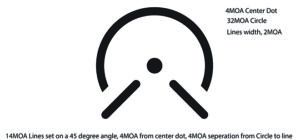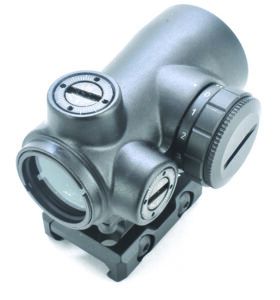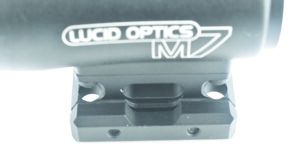We presented test results in the March 2020 issue about everyday-carry pistols with slide-mounted red-dot sights. As a result of that piece, Gun Tests readers sent in requests asking for more information about the new sights. When you ask, we try to deliver, so we hit the topic a second time in the November 2021 issue. Questions about still more additional optics followed immediately, though our responding readers seemed to be particularly interested in the Holosun brand. So get in, sit down, and hold on because we have new dope on four more sights for you, including the new Holosun AEMS (Brownells.com, 100-043-828WB, $399), Lucid Optics M7 (OpticsPlanet.com, $215), the Swampfox Justice model (Amazon.com, $235), and the Crimson Trace Rad Pro (MidwayUSA.com, $280).
We tried to keep the same testing format we used for the previous tests. Then we remembered the frustration we had with mounting systems for pistols, but still wanted to test the sights in a competition arena. We also wanted to see which products were flexible enough to be mounted on different platforms. So, we grabbed a SIG MPX 9mm that we use for USPSA Pistol Caliber Carbine (PCC) division and started shooting. We sighted in each red dot in turn, then shot them for feel and function at American Shooting Centers in west Houston. We shot the carbine/optic combo in practice for about a month and then finished everything off with a USPSA match. Observations were recorded at each step along the way. We still had a stash of Remington 115-grain 9mm ammo we were able to use for the tests.
Along with the factors we tested for in the past, we wondered if the “dot and a donut” reticle from the Holosun or the simple red-dot reticle like on the Swampfox would be faster. To see, we set up an “A Zone” plate (approximately 6 by 11 inches) at 9 yards and did one-shot drills from USPSA ready (port arms with the buttstock resting on the belt, safety engaged, and finger off the trigger). The differences were statistically insignificant — less than 0.02 seconds on average. Pick the reticle/body style you like and practice, practice, practice.

Our SOP has been to mount low- or zero-magnification optics well forward on the Picatinny rail. Just for giggles, we mounted various optics all over that mount — forward, middle, and rear. We decided, very subjectively, that we liked our existing practice and settled for mounting the red dots as far forward on the rail as possible while still keeping them actually attached to the receiver. We felt this method allowed us to focus on the reticle most quickly with both eyes open. It also seemed to allow us to point the carbine more naturally and helped us find the dot.
We understand that these manufacturers established their mount height with a different goal in mind than what we had in these tests. We were running the red dots on a competition-type pistol-caliber carbine in a United States Practical Shooting Association setting. We were looking for high-speed no-drag red dots that were easy to acquire and fast to use. The makers of our sights were generally trying to allow more defensive-minded users to co-witness their back-up iron sights through the lower parts of the dot windows in case the optic failed. Smart — and we don’t disagree with the concept at all. We just really liked the option to bring the sight to a lower level, which allowed us a more secure cheek weld. Lucid supplies its dot with multiple-height mounts, and Swampfox has a lower mount available on its website.
So with those fine points covered, we went to the range and shot these sights side by side.
Gun Tests Grade: B+
$215
Lucid Optics is a relatively new company and is perhaps not as widely known as others we have examined. Founded in 2009, they describe themselves as “On Target and Under Budget.” Something of a price brand, we also found some good features on the M7 red dot. Most of the dots we have tested use a reticle that is a single centered dot or a dot in a circle. The M5 reticle on the Lucid uses a 4-moa dot, framed by about 60% of a 32-moa semi-circle above it. Below that, at 45-degree angles, are two 14-moa lines pointing to the dot. Everything combined does a good job of attracting the eye to the dot. The dot has 11 brightness settings progressing from compatible for NVG use to bright, but not quite as bright as we would have liked. We were testing the dot on a very sunny day and, set on the brightest setting, the dot was visible but a bit washed out. We would have liked to see the intensity setting go up about two more notches. That being said, the reticle was very crisp and did not bloom at even the highest levels.
| Weight | 4.4 oz. |
| Length | 2.6 in. |
| Width | 1.18 in. |
| Dot Size | 4-moa dot, 32-moa circle |
| Height Above Rail | 1.3 in. |
| Sight Window | 25 mm |
| Mount Type | Modular Picatinny rail |
| Battery Type | CR2032 |
| Battery Change | Slotted battery cover right side |
| Estimated Battery Life | 1000 hours |
| Control Location | Top and right side |
| Warranty | Limited lifetime |
| Telephone | (307) 463-2633 |
| Website | LucidOptics.com |
| Made In | China |

This sight is nitrogen purged, which should keep it fog proof, and it is rated to withstand recoil on rounds up through the likes of a .458 Socom. The M7 carries an IPX8 waterproof rating, which is a good bit more stringent requirement that the IPX7. The “8” series is tested to a depth of 3 meters instead of 1 meter and is left submerged longer. The objective lens is round with a diameter of 25mm.
The Lucid uses a CR2032 battery with an estimated life of 1000 hours. The elevation control is on the top, and the windage is on the right side. Adjustments are 0.5-moa per click. There are arrows on the adjustments showing the direction to turn the knobs up or right. We used those indicators as we sighted in and found them to be backwards, pointing the opposite direction of what they said. Corrections were a snap to make once we were sure what was going on.

This Lucid scope is designed to be mounted on a Picatinny rail, and we loved what they did with the mounting system. Three Pic rail mounts of different heights are included in the package. We found the middle height fit the big folks best. One of them is bound to work for you. The left rail that tightens to hold onto the Pic rail is full length and held on by two screws, both of which project into the rail and further act as a recoil lug.
Our Team Said: The Lucid M7 was easy to install, secure when done, and simple to use once the adjustments were figured out. The unique reticle did a good job of attracting the eye and framing the target — it just needs to be a little brighter. Getting a proper cheek weld is very important with a long gun, and Lucid’s selection of mounts made that task very easy.





























Kamagra Commander maintenant [url=https://kamagraprix.com/#]achat kamagra[/url] kamagra 100mg prix
kamagra pas cher [url=http://kamagraprix.com/#]Kamagra pharmacie en ligne[/url] kamagra en ligne
Kamagra Oral Jelly pas cher [url=http://kamagraprix.com/#]kamagra en ligne[/url] kamagra 100mg prix
trouver un mГ©dicament en pharmacie [url=http://pharmafst.com/#]Livraison rapide[/url] п»їpharmacie en ligne france pharmafst.shop
pharmacie en ligne sans ordonnance [url=https://pharmafst.com/#]pharmacie en ligne pas cher[/url] pharmacies en ligne certifiГ©es pharmafst.shop